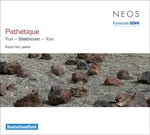Bote & Bock
By the time of the Concerto for Cello and Orchestra (1975/76) the "main tone" A had without doubt become for Isang Yun a cipher for harmony, purity and perfection. In formal terms the A in Interludium fashions an axis of symmetry and of reflexion. The note A appears insistently in several octaves, becoming an axis in tonal space and the centre of symmetrical choral agglomerations; it is present, too, as an imaginary centre of reference, also where the music is hollowed out. lt is as if this note is being viewed under shifting light conditions. After Ravel's "Le Gibet" [The Gallows] from Gaspard de la Nuit and the Tenth Piano Sonata by Alexander Skriabin, Interludium A is the most decided attempt in the history of piano music to examine a single note. The overall form of Yun's composition may be interpreted as tripartite but also as being in five parts.
Interludium A begins with an introductory 12 passage built from massive chords, ones which - read from the bottom to the top - are presented in the most extreme registers of the piano. By drawing on melismatic twists and turns and by providing a wealth of ornamentic detail, Yun aims to render unyielding chordal agglomerations more readily plastic. In a meditative and melancholy slow section, which once again enters a darker mood and only gradually reaches the higher registers, Yun returns to the main note A, and various other chromatic neighbours. A lively bridge passage renders more sinuous and fluid previously quite static elements. Use of variation technique allows Yun to combine ever-expanding melismas with up-ward and downward movements, ending in a series of domains typified by trills. The rigid chords return one last time. And it is perhaps with a sense of forgiving that Yun lets the most delicate prospects of sound emerge within the quiet closing dynamics of an extended finale.
Walter-Wolfgang Sparrer (translation: Graham Lack)

Kaya Han, piano
NEOS 20803
